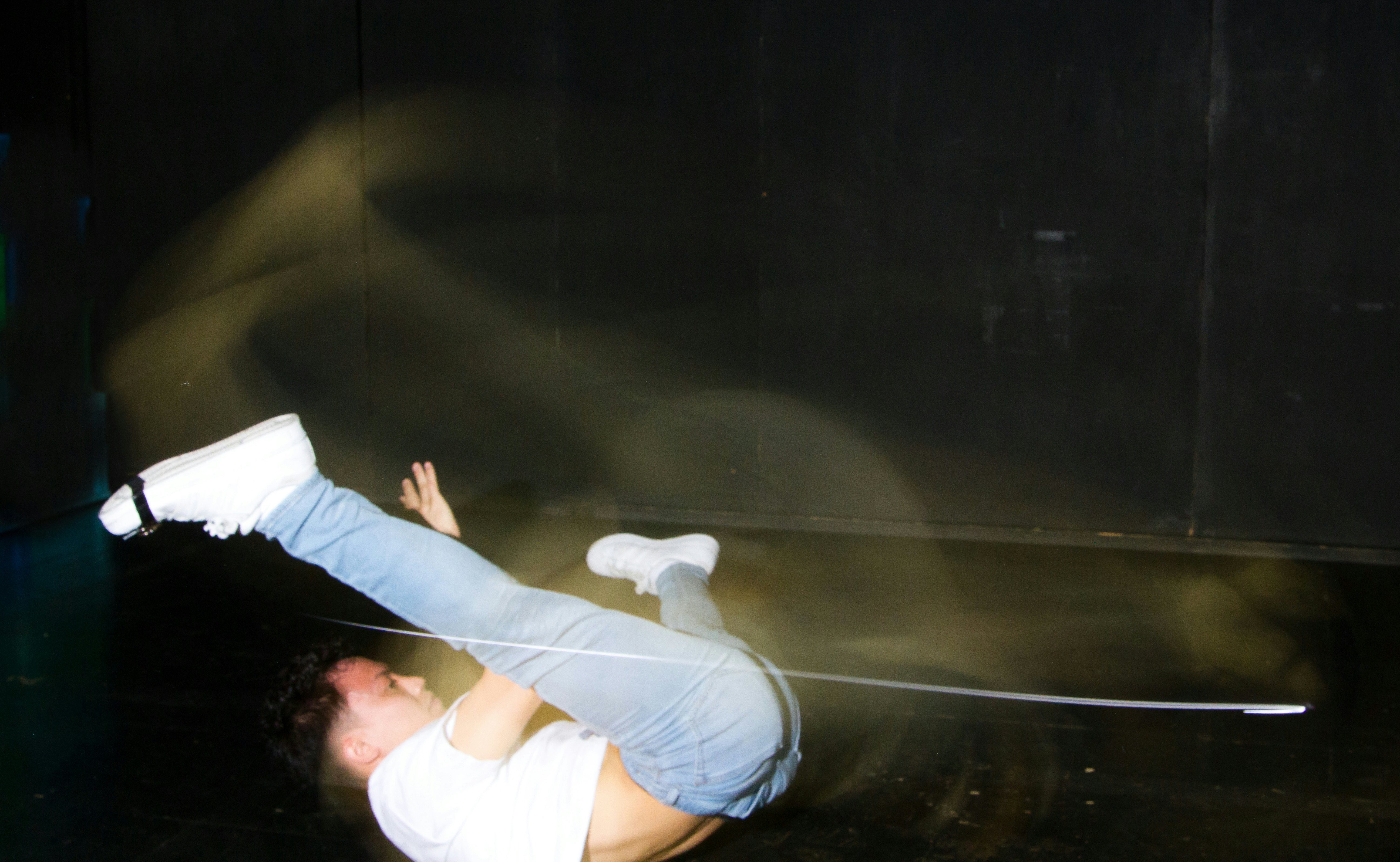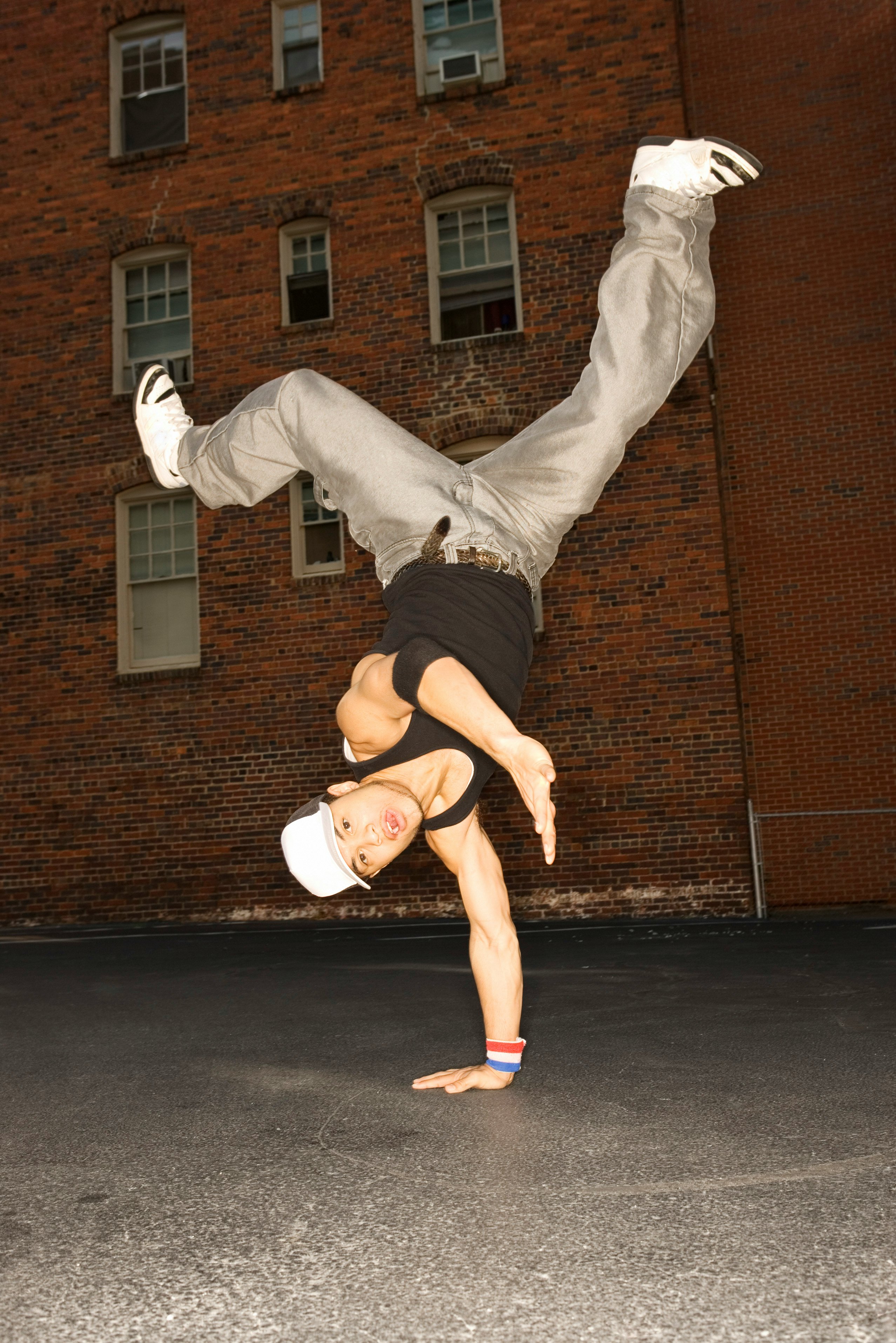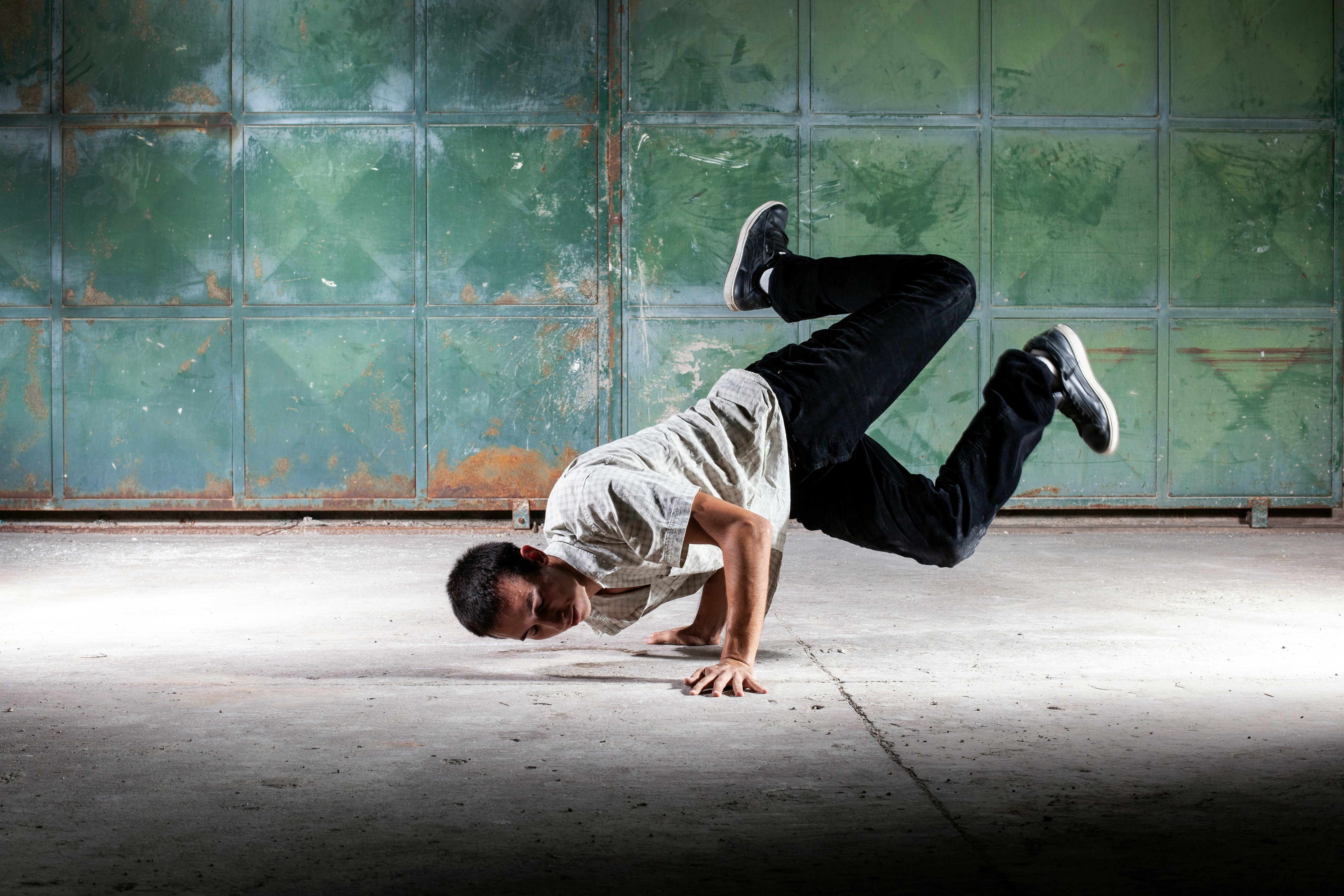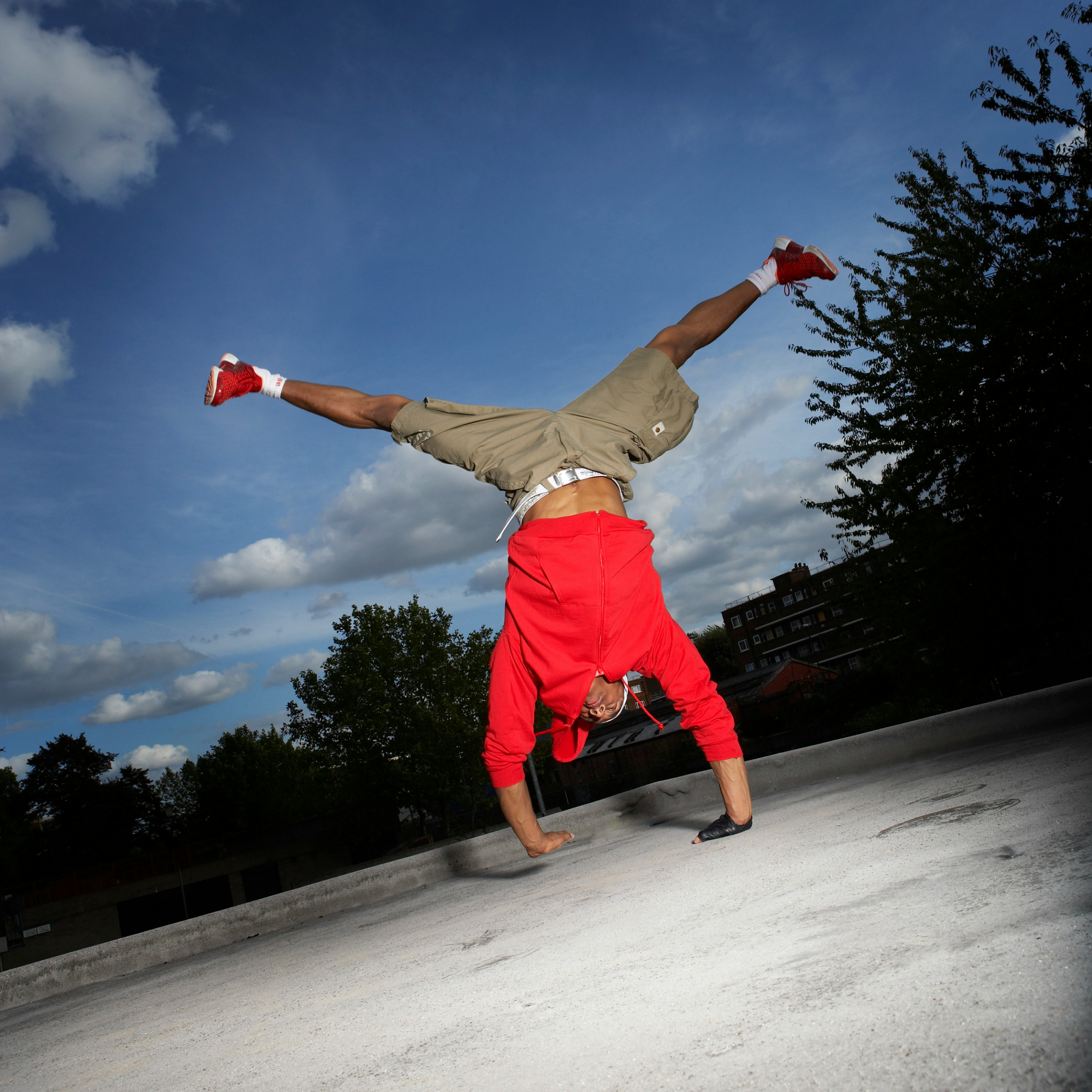
In June, Vicki “La Vix” Chang and Logan “Logistx” Edra headed off to an event that felt more like a party than an Olympic qualifier series. The music blasting during their routine was the biggest tell: LL Cool J’s “Mama Said Knock You Out” filled the room as they sashayed around the stage, spinning, flipping, twisting — breaking. The two each got two rounds to show their stuff.
La Vix, 33, started the round with top rock, or the swift hand and foot combination moves made while standing. Her coordination and agility belie years of practice, though her swagger makes it look effortless. After this introduction, she transitioned to the floor moves. At one point, she was fully upside down, swiveling on the top of her head while her feet extended skyward. She struck a pose to mark the end of her first round.
Logistx, 21, kicked into top rock, leaping around the stage. She executed a one-handed spin and then dove into a backspin. With equal parts strength, flexibility, and coordination, both breakers bent physics to their will, throwing down power moves from every direction in order to make it to the Olympic Games.
Physics is everywhere in Olympic sports. Whether it’s fighting gravity in a ski jump, working against the pressure of a gnarly wave, or limiting drag in a bike sprint, athletes use intuition, training, and technology to excel. Breaking is no exception. At a glance, the sport is something like a floor routine in gymnastics, but without pause or wind-up — not to mention better beats. Breakers don’t don’t get a running start to gain their momentum — they must create it with their floor movements. When they want to, they can look frictionless. They can glide when others might stumble, and can point straight in the air instead of crumpling under gravity. Scientifically, breaking is a master class in angular momentum, axis of rotation, and center of mass, with power moves that seem to defy nature when really they make use of physics and incredible strength.
The Inertia That Drives The Windmill

The Windmill is a flashy move that you commonly see in breakdancing competitions. That doesn’t mean it’s easy. To pull it off, the breaker creates a vertical axis of rotation at the point where their torso comes into contact with the floor. With legs straight and in a “V,” they start a spin and power through — usually in the middle of a routine, entering and exiting the move with smooth ease.
Much of the physics behind the move relies on the moment of inertia, which is an object’s resistance to changes in its rotational motion depending on how its mass is distributed. Another way of thinking about that is how prone an object is to rotate about its axis based on its distribution of mass throughout. A b-boy or b-girl can change their distribution of mass, and therefore their moment of inertia, by positioning their limbs in different ways.
Then there’s angular velocity, which is the speed at which a mass travels in a circle. The breaker uses his hands to set off that angular velocity before splaying his legs up and out. Multiplying moment of inertia by angular velocity gives you angular momentum, which is the key here.
“Now that he's already rotating, he's going to work rotating about an axis using the legs to create that angular momentum,” says Amy Pope, a senior lecturer in physics and astronomy at Clemson University. The angular momentum of the feet is ultimately what helps the breaker rotate.
The larger the moment of inertia and angular velocity, the larger the angular momentum. By splaying out the legs, the breaker creates a bigger moment of inertia. The b-boy or b-girl might also put their hands down occasionally to build up more angular velocity, powering the rotation.
1990s, Mastering The Axis Of Rotation

This power move consists of transitioning from a handstand into a full, one-handed spin before putting the other hand down.
When rotating on one hand, the breaker creates another vertical axis of rotation. With the other hand, they use friction and torque to set themselves spinning. Torque is a twisting force that is the distance from the axis of rotation — their palm that stays on the floor — to where the force is applied — the other hand that’s pushing off — multiplied by the force. It’s imperative they keep their weight over the axis of rotation, lest they lose balance. You’ll see there’s a straight line from the hand on the floor up through their belly button: That’s the axis of rotation.
Centrifugal Force In The Continuous Headspin

No one would be able to pull off the continuous headspin without some important hacking of friction and the smart use of centrifugal force. “Physics here is the hero because it's what makes this move possible,” Pope says. She first notes the hat’s importance in reducing friction between the breaker’s head and the floor. She makes the analogy of going down a slide. If you’re wearing shorts, there’s more friction between your legs and the slide. But if you’re wearing pants, that reduces the friction which lets you slide down more quickly and easily. Likewise, a hat reduces friction between the dancer’s head and the floor.
Then she gets into the motions. With hands planted on the floor in a headstand, the breaker swings their legs around to start the spin, gaining angular momentum. They use their hands to stabilize the torso before spinning. Then they begin to rotate, but the official headspin has yet to begin. They plant their hands with every 360 degrees made. As they rotate, they use their hands to cause angular acceleration, which helps them gain speed every time they put their hands down.
Then their hands come up. At this point, they pull in their legs, decreasing moment of inertia and increasing angular velocity. By pulling in their legs, the breaker’s rotations speed up, displaying the principle of the conservation of angular momentum. That means as angular velocity and moment of inertia change, angular momentum must remain constant.
Jackhammer, An Exploding Center Of Mass

“This one is all about center of mass,” Pope says. A body’s center of mass is the point representing the average position of its mass. Pope says typically our center of mass is located near our belly button, but depends on the distribution of our muscles.
In the jackhammer, this breaker’s elbows are near their center of mass, making the center of mass also his axis of rotation. As they push up against the ground with their hand, they apply an upward force, lifting their body while rotating their hand a few degrees. “This one is just exploiting center of mass and having really strong muscles,” Pope says.
If their hand is too far from his center of mass, then they will fall over. The further their hand from this center of mass, the more likely they are to fall.
Of course, nobody is coming out with instruments to measure their exact center of mass. It’s intuitive. “The individual's center of gravity at that point, in motion, is what they need to become aware of,” Henry “Rival” Vijande, head coach at the Bboy Bgirl Lifestyle dance school, says. “Where the center of their movement is within them [will] help them guide the movement to the power move.”
Playing With Gravity In An Airflare

This airborne, rotating handstand is all about defying gravity — by using sheer muscle, Pope says. In order to accomplish what may be the most physical common move in breaking, a breaker needs “sufficient angular velocity,” Pope says, “but it looks like their angular velocity is fairly consistent throughout that entire motion.”
In other words, the breaker remains in a handstand position while throwing their body in a circle — one hand at a time, they push off from the ground into the air, and then spin back down, again one hand at a time. “It’s really kind of a graceful falling in a circle,” Pope says. This move, essentially, is a windmill performed on your hands, requiring plenty of upper body strength.
“A lot of this is just based on the sheer power of the athlete,” Pope says. “Rather than just harnessing science, that's a lot of raw power.”







